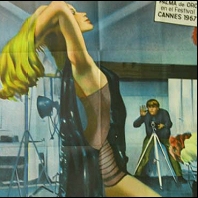 A young girl's dream is to become a fashion model; my vision was to become a press photographer. In the back of my mind I would always be eyeing the cool possibility of "shooting" (and seducing) young models, like David Hemming in Michelangelo Antonioni's sensual and mysterious 1960's film "Blow Up". My obsession with cameras gave me the assurance that if I failed, at least I could not blame it on my equipment.
A young girl's dream is to become a fashion model; my vision was to become a press photographer. In the back of my mind I would always be eyeing the cool possibility of "shooting" (and seducing) young models, like David Hemming in Michelangelo Antonioni's sensual and mysterious 1960's film "Blow Up". My obsession with cameras gave me the assurance that if I failed, at least I could not blame it on my equipment.
 The beginnings were modest, fully in line with the rags-to-riches legend I hoped for. My first camera - in primary school, and in my first boarding school year - was a second-hand 6x9cm Agfa box. View from top through a tiny glass square, click and wind. That's all one could do. No focussing, no worry about exposure times.
The beginnings were modest, fully in line with the rags-to-riches legend I hoped for. My first camera - in primary school, and in my first boarding school year - was a second-hand 6x9cm Agfa box. View from top through a tiny glass square, click and wind. That's all one could do. No focussing, no worry about exposure times.

 In my second boarding school year, for my 12th birthday, my parents surprised me with a more "sophisticated" Dacora Digna, sporting a retracting Achromat 1:8 to 1:11 lens and 12x120 roll-film format, so called because it allowed 12 pictures of 6x6cm size. The retracting cylinder housing the lens did not fit tightly against its "collar", so most of the photographs taken at school are adorned with a circular aurora.
In my second boarding school year, for my 12th birthday, my parents surprised me with a more "sophisticated" Dacora Digna, sporting a retracting Achromat 1:8 to 1:11 lens and 12x120 roll-film format, so called because it allowed 12 pictures of 6x6cm size. The retracting cylinder housing the lens did not fit tightly against its "collar", so most of the photographs taken at school are adorned with a circular aurora.
 At university, I made a giant leap by scraping together my savings from part-time work at the International Atomic Energy Agency for a used 1954 36mm Edixa-Reflex with a waist-level viewfinder and a cloth shutter with that magical speed of 1/1000 of a second, using impressive East German lenses from Jena. This took place on the 5th of February 1963 and I dished out a staggering 1,100.- Austrian Schillings to Photo Porst.
At university, I made a giant leap by scraping together my savings from part-time work at the International Atomic Energy Agency for a used 1954 36mm Edixa-Reflex with a waist-level viewfinder and a cloth shutter with that magical speed of 1/1000 of a second, using impressive East German lenses from Jena. This took place on the 5th of February 1963 and I dished out a staggering 1,100.- Austrian Schillings to Photo Porst.
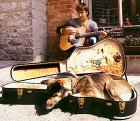 The waist-level viewfinder allowed me to shoot unnoticed and even "around the corner": by holding the camera in vertical format at eye level, I was looking "north" but really shooting "east". Most people, when photographed, notice the photographer's viewing direction, and not the camera lens. Equally, I could raise the upside-down-held camera over the heads of competing press photographers and still view the scene to be shot. Today's latest Sony video cameras use a similar principle with their foldout viewfinder screen. After another conference assignment at the Agency, I was able to add a prism viewfinder and a super Carl Zeiss Jena Flektogon 20mm f4 wide-angle lens. For, even today, super wide-angle shots are my way of adding foreground-background contrast and drama to my views of the world.
The waist-level viewfinder allowed me to shoot unnoticed and even "around the corner": by holding the camera in vertical format at eye level, I was looking "north" but really shooting "east". Most people, when photographed, notice the photographer's viewing direction, and not the camera lens. Equally, I could raise the upside-down-held camera over the heads of competing press photographers and still view the scene to be shot. Today's latest Sony video cameras use a similar principle with their foldout viewfinder screen. After another conference assignment at the Agency, I was able to add a prism viewfinder and a super Carl Zeiss Jena Flektogon 20mm f4 wide-angle lens. For, even today, super wide-angle shots are my way of adding foreground-background contrast and drama to my views of the world.
By that time I had realised that the single lens reflex system with exchangeable lenses was the only way to go. The fact that my Edixa Reflex had the 42mm Pentax/Practica lens screw-mount, would benefit me greatly when I eventually moved on to my next camera, the Pentax Spotmatic that accepted all my lenses I had used with the Edixa. Today, single-lens reflex cameras prefer the faster bayonet mount.  I can proudly lay claim to have acquired the first freshly imported Pentax Spotmatic sold in Vienna. Asahi had announced its new
through-the-lens-metering concept already two years earlier, and I had held my breath to order this avant- garde model design. In due course, all great camera makers such as Contax, Nikon and, ultimately even Leica, followed Pentax' footsteps in this respect.
Asahi produced the first Japanese SLR in 1954 and went on to put the first pentaprism into an SLR in 1957 (the first Pentax). The Asahi Spotmatic was the world's first SLR with TTL metering (originally intended to be a spot meter, hence the name Spotmatic, but an averaging meter went into production) produced in 1964. The Spotmatic had defined everything to go into a SLR with a TTL meter.
I can proudly lay claim to have acquired the first freshly imported Pentax Spotmatic sold in Vienna. Asahi had announced its new
through-the-lens-metering concept already two years earlier, and I had held my breath to order this avant- garde model design. In due course, all great camera makers such as Contax, Nikon and, ultimately even Leica, followed Pentax' footsteps in this respect.
Asahi produced the first Japanese SLR in 1954 and went on to put the first pentaprism into an SLR in 1957 (the first Pentax). The Asahi Spotmatic was the world's first SLR with TTL metering (originally intended to be a spot meter, hence the name Spotmatic, but an averaging meter went into production) produced in 1964. The Spotmatic had defined everything to go into a SLR with a TTL meter.
In 1968, following an ad in the paper, I was accepted as assistant to press photographer Oskar Horowitz, whose house in the fashionable outer district of Grinzing, contained two photo labs. There I learned to catch the latest police reports on a short-wave radio, rushed to the scene of accidents or arrivals of "celebs", sporting my "trespass press- pass", and competed with the newspaper-owned photographers. Speed was the essence. Alas, I had to rely on my battered, spattering, bumperless VW beetle. After a screeching halt back at the lab, I rushed to the "red" room, speeding up the negative-drying process by pulling the wet film strip through a bath of pure alcohol and using - - - a hair dryer. Paper prints, drying drum, copyright stamp, race to the car, rush to the offices of five newspapers located all over town: Die Presse (Conservative), Kurier (bourgeois), Kronenzeitung (tabloid), Arbeiterzeitung (Socialist) and Volksstimme (Communist), the latter two, sadly, long gone. The in-house photographers had the no-extra-cost advantage. In many cases, the lone editor of the Volksstimme whom I always visited last and who didn't have an in-house photographer, asked: "Did the others take any of these?" and if they hadn't, he would buy at least one of my pictures, giving him some sort of exclusivity, and myself the satisfaction of having earned at least 100 Schillings that day. My best day was often on Monday, when the newspaper photographers were working off their weekend hangovers, and I was able to sell to all the papers, bringing home anywhere from 500 to 1,000 Schillings. Other than with press photos, I also earned a few Schillings by working for architects who appreciated my skills in architectural photography, including scale models and construction progress. The mayor of Leoben, a proud industrial city in the "forest province" of Styria, gave me an assignment to prepare a photographic volume about his town. My resulting portfolio was accepted enthusiastically, but never realised in print. The most lucrative photographic assignments I got were for weddings. There was virtually no limit to the amount of pictures purchased by the bride's and the groom's parents. I charged them according to the lavishness of the wedding. As fate has it so often, almost nothing remains of the vast amount of photography I did at the time. Whatever did survive at least a dozen household moves, is represented in a few samples on this page. After I moved to Toronto, Canada, I switched from my Asahi Pentax Spotmatic to NIKON and a handsome calf leather case. My new equipment existed of Nikon's top SLR model at the time, the Nikon FT (T for Titanium). My lens set consisted of a super-wide angle Flektogon Carl Zeiss Jena 20mm f/4 (the widest non-fisheye lens at the time, yet I did have an 18mm Fisheye Lens with my Asahi Spotmatic); a super-bright Nikon 55mm f/1.2; for portrait photography a 85mm f/3.5 Nikon lens; and for teleshots a Nikon NIKKOR 300mm f/4 - definitely not recommended for hand-held shots unless a good support was available. |
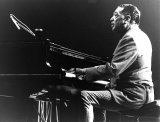 Duke Ellington 4 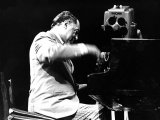 Duke Ellington 3 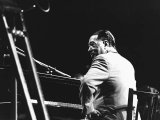 Duke Ellington 2  Duke Ellington 1  Lionel Hampton 1 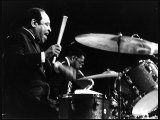 Lionel Hampton 2 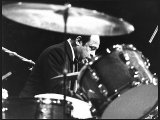 Lionel Hampton 3 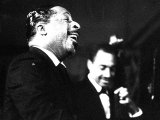 Erroll Garner 1 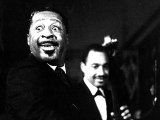 Erroll Garner 2 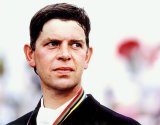 Rider  Marlene 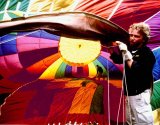 Balloon 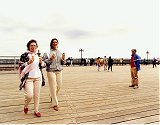 Ice Cream! 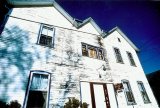 Ontario |
||
| Back to Peter Panholzer's Home Page | |||